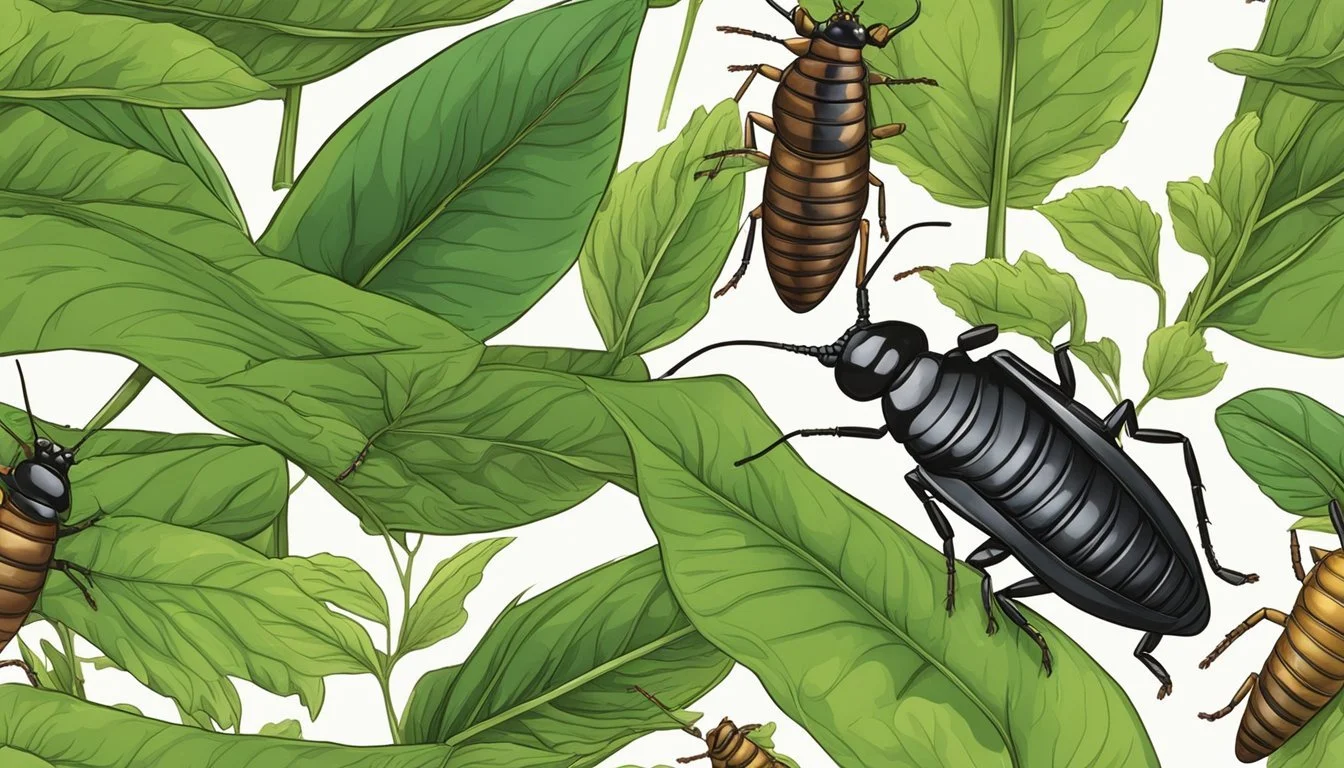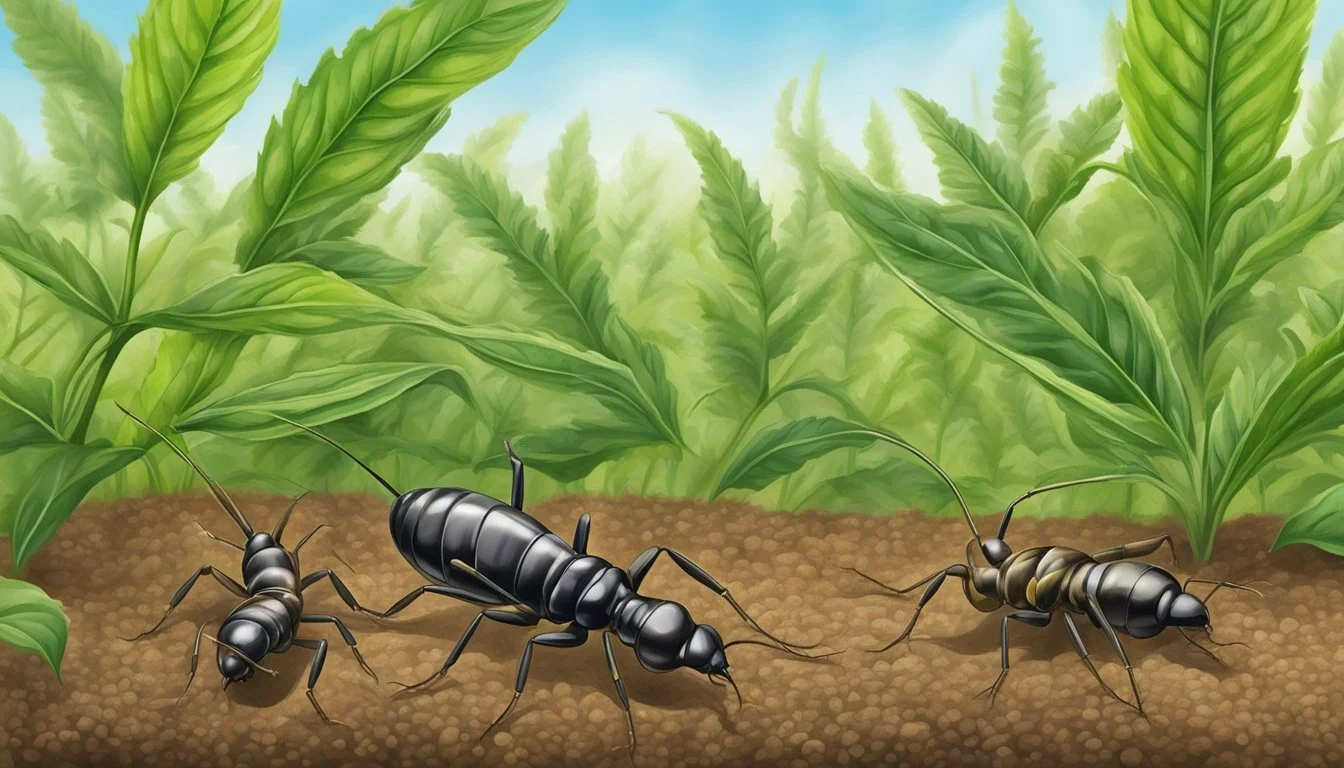Protecting Crops from Earwigs
Effective Strategies for Gardeners
Earwigs are small insects recognizable by their pincers on the back of their abdomens. While they play a role in the ecosystem by feeding on decaying plant material and small pests, they can also inflict considerable damage on a wide variety of plants in gardens and crops. When their population is unchecked, earwigs may harm seedlings, flowers, and fruit, leading to significant agricultural losses. It is essential for gardeners and farmers to understand the behaviors of earwigs to protect their plants effectively.
These insects are nocturnal and prefer moist, sheltered environments. During the day, earwigs hide in cool, dark places before emerging at night to feed on plants. They are particularly drawn to young, tender foliage and soft fruits, occasionally resulting in chewed leaves, damaged flowers, and scarred fruits. This not only diminishes the aesthetic value of ornamental plants but can also reduce the marketability and yield of crops.
Controlling earwig populations in the garden and on the farm involves both preventive measures and targeted interventions. Maintaining a clean garden by removing potential hiding spots and establishing traps can significantly reduce their numbers. For yet tougher cases, certain methods like pesticide application can offer relief. Understanding how to manage these pests in a balanced and effective manner is key to keeping plants healthy and productive.
Understanding Earwigs
Earwigs are a distinct group of insects, known for their unique physical characteristics and behaviors that affect their interaction with the environment, particularly horticulture.
Identifying Earwigs
Forficula auricularia, commonly known as the European earwig, is characterized by its pair of forceps-like pincers or cerci at the end of its abdomen. These insects are typically brownish to black in color and can be identified by their elongated bodies, which measure up to 16 mm in length. They possess wings, although they are rarely used for flight.
Earwig Life Cycle
Earwigs undergo incomplete metamorphosis, starting from eggs to nymphs before reaching adulthood. A single earwig can lay dozens of eggs in a season, and these eggs are usually laid in the soil. Nymphs resemble adult earwigs but are smaller in size and after several molts, they reach maturity.
Earwig Habitat Preferences
Earwigs are predominantly nocturnal creatures and display a preference for dark and humid environments. During the day, they can often be found under rocks, logs, or even within dense foliage. These habitats are ideal for earwigs as they need moisture to thrive and the cover of darkness to protect them from predators and the heat of the day.
Earwigs and Ecosystem
Earwigs are intriguing insects that have both beneficial and detrimental impacts on gardens and ecosystems. They are omnivores that contribute to the environment as natural predators but can also become garden pests if their population is not controlled.
Earwigs as Pests and Predators
Earwigs are known for their dual role in the ecosystem—they are both pests and predators. As pests, they are capable of damaging a wide variety of plants, particularly seedlings and soft fruits. Their nocturnal feeding habits can lead to significant harm to horticultural crops and garden plants. Conversely, as predators, earwigs feed on a multitude of insects and mites, playing a critical role in controlling the populations of other garden pests.
Their predilection for organic matter also makes them beneficial for compost decomposition, aiding in nutrient recycling and soil health. They consume decaying leaves, plant debris, and dead insects, which helps to break down and recycle organic matter back into the soil.
Earwigs' Role in the Garden
In the context of a garden, the impact of earwigs is dual-faceted. They assist in maintaining the garden's health by serving as natural predators of pest species, thus can be considered part of biological pest control. However, when earwigs are abundant, they may cause damage to flowering plants and vegetables, leading to concerns among gardeners.
Balancing their population is key. Gardeners can create an ecosystem where earwigs contribute positively, without letting their numbers increase to the point where they inflict noticeable damage. Practices like managing garden debris to limit earwigs' hiding places can moderate their presence, ensuring that their role as predators aids the garden without tipping the balance into pest territory.
Preventing Earwig Infestation
Preventing earwig infestation centers on creating an unfavorable environment for them to thrive. This includes employing specific cultural practices, constructing physical barriers and traps, and introducing biological control methods.
Cultural Practices
Cultural practices play an essential role in managing earwig populations. Maintaining a clean garden is critical; one should remove garden debris, such as leaf litter and decaying vegetation, which can provide shelter for earwigs. Regularly disturb the soil around plants to disrupt the earwigs' habitat. It's also beneficial to avoid excessive mulching or keep organic material such as compost piles well-managed to deter earwigs from settling in.
Physical Barriers and Traps
Implementing physical barriers and traps can be very effective. Barriers like diatomaceous earth sprinkled around the base of plants can deter earwigs. For traps, one can use shallow containers filled with vegetable oil or a mixture of soy sauce and oil to create an earwig trap. Alternatively, placing damp newspaper, boards, or cardboard around the garden at night can attract earwigs, which can then be collected and removed from the garden in the morning.
Biological Control Methods
Biological control methods harness natural predators to reduce earwig populations. Birds, toads, and the tachinid fly are known predators of earwigs and encouraging their presence in the garden can provide long-term control. One may do so by installing birdhouses or creating a garden environment that is hospitable to these beneficial creatures, aiding in the management of earwig numbers naturally.
Organic Control Measures
Organically managing earwigs involves leveraging nature-friendly solutions that target the reduction and control of earwig populations without harming the environment. By using homemade remedies, encouraging natural predators, and applying organic insecticides, gardeners can protect their crops while maintaining ecological balance.
Homemade Remedies
Creating mixtures with household ingredients such as dish soap can be an effective organic strategy. A solution of soapy water, made by combining a tablespoon of organic liquid dish soap with a quart of water, can be sprayed directly on earwigs to eliminate them. This approach, while simple, can be a frontline defense in managing minor infestations.
Materials: Organic liquid dish soap, water.
Procedure: Mix, apply to earwigs using a spray bottle.
Natural Predators and Beneficial Insects
The promotion of natural predators like the tachinid fly can aid in controlling earwig populations. These predators feed on earwigs, thereby naturally reducing their numbers without chemical intervention. Gardeners can attract such beneficial insects by planting a diverse range of flowers and herbs that provide a habitat for these allies.
Effective Predators: Tachinid flies, birds, toads.
Attractants: Floral diversity, night-time lighting.
Organic Insecticides
For more severe infestations, organic options like diatomaceous earth and neem oil can be useful. Diatomaceous earth is a powder made from the fossilized remains of tiny organisms, which acts as a desiccant, drying out the earwigs' exoskeletons leading to their demise. Neem oil and azadirachtin-based products disrupt the life cycle of earwigs without introducing synthetic chemicals into the environment.
Application: Sprinkle diatomaceous earth, spray neem oil on affected areas.
Caution: Use food-grade diatomaceous earth and follow usage instructions for neem oil to ensure safety.
Chemical Control Options
When managing earwigs, chemical control should be employed judiciously, taking into account the potential impact on the environment and non-target organisms. Pesticides are an effective part of an integrated pest management strategy, primarily when non-chemical methods are insufficient or earwig populations become too large.
When to Use Pesticides
Pesticides should be considered for earwig control when there is significant crop damage and non-chemical methods have failed to reduce their population to acceptable levels. Timing is crucial; gardeners and managers need to apply pesticides when earwigs are most vulnerable, such as in the young nymph stages or when they aggregate in large numbers.
Selecting the Right Pesticide
Selecting an appropriate pesticide requires understanding the specific needs of the situation. Options include broad-spectrum insecticides, which can affect a wide range of insects, or targeted pesticides with a narrower focus. For instance, neem oil is a natural insecticide that can help manage earwig populations while being less harmful to beneficial insects.
Application and Safety
The application of pesticides should be carried out according to the product's label instructions, using the recommended personal protective equipment to ensure safety. Proper application techniques are essential—spraying directly onto infested areas and avoiding drift to non-target areas are critical steps. Gardeners and pest control managers must adhere to safety guidelines to protect themselves, others, and the environment from unintended exposure or harm.
Identifying and Assessing Damage
When it comes to protecting crops from earwigs, early identification and proper assessment of damage are crucial. This involves recognizing the signs of their presence and understanding the types of plants and materials they typically affect.
Signs of Earwig Presence
Physical Appearance: Gardeners should look for earwigs themselves, which are distinguishable by their pincers at the end of their abdomen. They hide during the day and are active at night, so nighttime inspections with a flashlight can be particularly effective.
Damage Indicators: Earwig damage is characterized by jagged holes and bite marks on leaves and soft fruits. Earwigs do not leave behind slime trails, unlike slugs, which helps distinguish their feeding habits.
Commonly Affected Plants and Materials
Plants: Both vegetable gardens and ornamental plants can fall victim to earwig damage. They have a particular appetite for leafy greens and soft fruit, such as apricots and berries.
Plant Stages: Young seedlings and flowering plants are especially vulnerable, as earwigs can cause significant damage to these more delicate stages of growth, potentially killing the plant.
Materials: Beyond live plants, they may also target dead plant material and various organic matter, contributing to their role in the ecosystem as scavengers.
Practical Tips for Gardeners
Gardeners can effectively protect their plants from earwigs by instituting regular checks, ensuring their garden does not provide a comfortable habitat for these pests, and maintaining proper garden hygiene. The following methods are specific to creating an environment that is less appealing to earwigs, while potentially targeting other garden pests such as aphids, mites, and slugs which can also harm crops.
Regular Monitoring
Check Plants Regularly: Gardeners should examine their plants, especially roses, dahlias, and zinnias, frequently for signs of earwig damage.
Nighttime Inspections: Since earwigs are nocturnal, inspecting the garden at night with a flashlight can help in locating and removing them manually from strawberries, lettuce, and sweet corn.
Cultivating Unfavorable Conditions
Reduce Humidity: Ensure that the garden has proper drainage to prevent moist areas where earwigs thrive.
Limit Mulch and Organic Material: Keep mulch levels moderate around plants like the butterfly bush to avoid creating humid environments. Remove garden debris promptly to reduce hiding places.
Garden Maintenance and Hygiene
Regular Cleanup: Remove fallen leaves and other garden debris consistently to minimize shelter for earwigs.
Garden Vacuum: If available, use a garden vacuum to remove earwigs from dense foliage areas efficiently.
Frequently Asked Questions
Earwigs can be both a nuisance and a danger to your garden, but there are numerous ways to address and prevent an infestation. Learn more about natural deterrents, effective methods, and the signs of earwig damage through these insightful questions.
How can I naturally deter earwigs from my vegetable garden?
Natural methods to deter earwigs include maintaining a clean garden to eliminate hiding spots, using traps like damp rolled-up newspapers or shallow containers filled with soy sauce and oil, and encouraging their natural predators, such as toads and birds, by providing a welcoming habitat for them.
What methods are effective in preventing earwig infestations in outdoor plants?
Preventing earwig infestations can be achieved through several methods, including reducing excess moisture and thick mulches around plants, establishing barriers like diatomaceous earth around stems, and removing sheltering debris from the garden.
Can organic remedies be used to control earwig populations?
Yes, organic remedies such as neem oil, insecticidal soaps, and diatomaceous earth are effective options for mitigating earwig populations without resorting to chemical insecticides.
Is there an ecological benefit to having earwigs in my garden?
Earwigs do play a role in the ecosystem by decomposing organic matter and preying on other garden pests. However, their habit of attacking living plants can outweigh these benefits when their numbers become too great.
What are some signs that earwigs are causing damage to my plants?
Signs of earwig damage include jagged or hole-ridden leaves, partially eaten flowers or foliage, and the presence of earwig excrement. These symptoms often appear overnight as earwigs are nocturnal feeders.
How can coffee grounds be used in managing earwig pests?
Coffee grounds can be used as a barrier because earwigs are repelled by the strong smell. Sprinkle coffee grounds around the base of plants to help deter earwigs and incorporate them into the soil to improve garden health overall.






